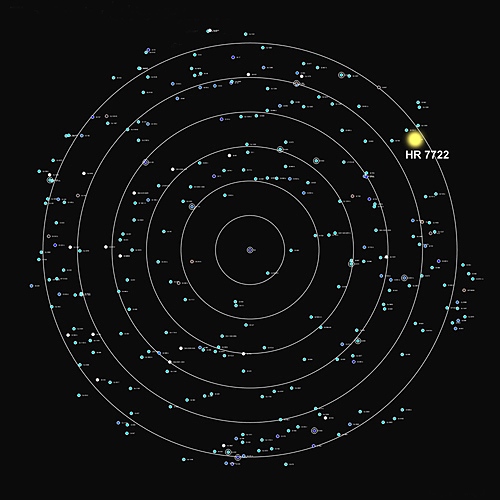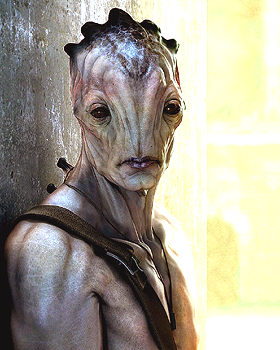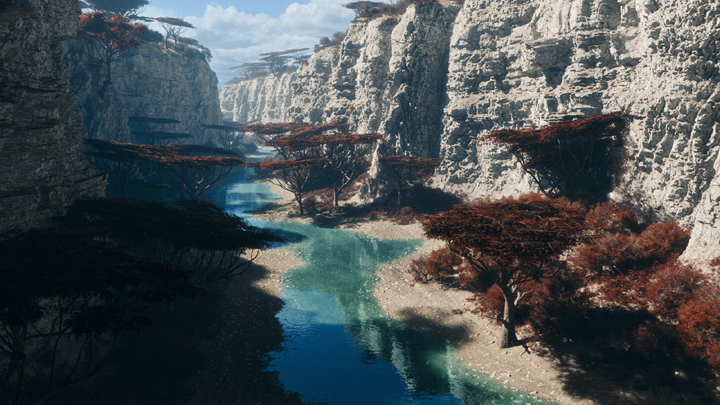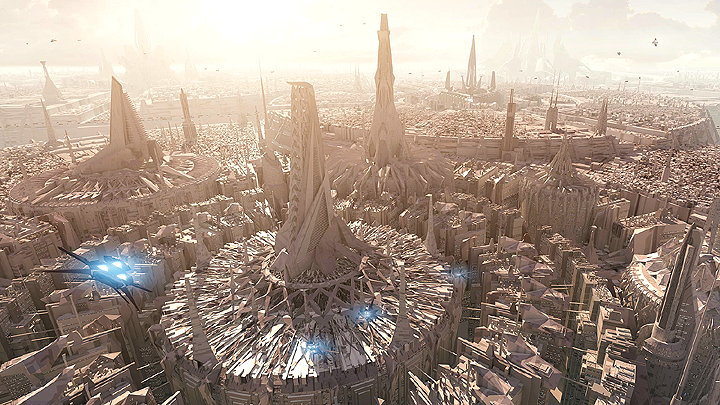
DISTANCE: 28.7 light years from Sol
NEIGHBORING SYSTEMS: Delta Pavonis 18.5 lys Altair 18.5 lys Gliese 876 19.7 lys
HR 7722 is an orange-red dwarf which has a total of six planets in orbit including two rocky worlds and four gas giants. Although evidence shows that, at one time, this system was filled with a great abundance of asteroids and cometary material, today, there is no inner or outer dust disc. Over billions of years this material either combined through frequent bombardments with the inner planets or slowly dissipated into regions outside the system’s perimeter.
KRELORNDRAN is the third planet in orbit and developed little more than bacteria and other primitive forms of life during its first 4 billion years due to heavy meteorite activity. After the bombardments began to diminish, more advanced life began to evolve in the oceans and later on land after the dust settled and a nitrogen-oxygen atmosphere was formed. Now, a massive, briny ocean covers approximately 40 percent of the planet’s surface with several small seas and lakes scattered across the landscape. The remaining landmasses are made up mostly of semi-arid deserts, extensive mountain ranges, and lush coastal forests. On average, surface temperatures are slightly warmer than Earth. Although this world orbits relatively near to its host star, it is not tidally locked. However, this close proximity does affect its rotational axis; causing the planet to experience 60 hour days and nights.
Krelorndran hosts a variety of unique and exotic lifeforms and is also the homeworld of the Brekka race.

The BREKKA are descended from a unique species of amphibious primates that spent equal amounts of time immersed in the briny oceans of their homeworld as they did climbing the swaying Ooxla trees along the coast. Over millions of years, their early ancestors gradually began to spend more and more time on land in order to escape the deadly predators that roamed the deeper waters. As they continued to evolve and eventually walk erect, they retained their gills which continue to function both on land and underwater.

Essentially humanoid in appearance, Brekka typically reach heights at adulthood of 2.5 to 3 meters tall. Their thin, sinewy arms and legs end with long, bony, partially-webbed hands and feet which are supported by a dense carbon-fiber skeleton. Their eyes, which are black and oval-shaped, are capable of seeing in both “normal” light and the infrared spectrum as well. Their mouths are filled with small flat teeth made for grinding vegetation and small fish, which make up the primary basis of their diet. They have no ears or noses to speak of. Instead, the center region of their frontal cranium is comprised of a V-shaped bony structure which protects a soft, spongy mass underneath. This mass of concentrated cells serves many functions such as absorbing vibrations in both the air and underwater and translating it into sound. It also gives them a heightened sense of balance and coordination. The top of their skulls are made up of upswept cranial ridges that end in small, bony protrusions. The number of these protrusions ranges anywhere from three to seven depending on the age and health of the individual.
The atmosphere of the Brekka homeworld contains a higher level of oxygen than Earth. Because of this, their bodies utilize hemocyanin rather than hemoglobin in the bloodstream. This copper-based system requires much less efficiency at transferring oxygen than an iron-based system and also contributes to their skin pigment which typically ranges from light green to grayish-blue in color.
Brekka have a highly complex nervous system which is distributed throughout the body in the form of millions of nerve clusters. This attribute gives them near instantaneous reflexes as well as the ability to sustain a high volume of injuries without any overall damage. Their sensory acuity also allows them to feel the heartbeat of another lifeform from as far as fifty meters away.
Although the amphibious Brekka continue to spend a great deal of their time near the ocean, all of their major cities are situated beyond the high cliff walls that border the shorelines of their world. They are an extremely gregarious species; constantly longing to be in the company of others. Due to this fact, most of them live in the highly populated cities which have been designed in a compact manner to bring them closer together. Other than minor differences in regional dialects, their language has changed very little over thousands of years. It is best described as a fluid series of honks, clicks, and guttural noises which is nearly unpronounceable by Humans. Proper names such as “Brekka” and their home planet of “Krelorndran” were derived from sounds that were loosely translated by the first Humans who encountered them.

Unlike many other races who tend to perceive life, death, and the unknown through superstition and religious doctrine, Brekka have based both their philosophical and spiritual concepts on a fundamental law of physics which states that neither energy or matter can be created or destroyed, but can only change from one form to another. This science-based observation led them to the belief that, after the physical body dies, an unending lifeforce continues on in a new form. They believe that the universe as a whole is interconnected by this energy and that every living being has a unique and significant purpose.
Their desire to connect with other forms of life beyond their own planet was what initially led them to develop technology that utilizes transient wormholes which provide shortcuts across vast distances in space. As they began to encounter a variety of beings on a number of different worlds, they became even more convinced that all life was interconnected by a living universe. Yet, they soon came to realize that their own technology was far more advanced than every other species they had come into contact with. Motivated by the belief that their intentions were both benevolent and noble, the Brekka began sharing their technology with these less-developed races. Some of these civilizations lacked a certain level of cultural maturity and conflicts among themselves were a constant threat. One particular world, populated by two warring factions, exploited this new technology to design more powerful weapons and then proceeded to use them against each other. The unexpected result of the Brekka’s generosity was that the entire population completely annihilated themselves before they even developed the means of leaving their homeworld.
The Brekka were in complete anguish over this total planetary genocide. Blaming themselves for this devastating loss of life, they adopted a strict new policy of non-interference with less advanced species. Although they continued to associate with those who had not been adversely affected by their presence, they were determined to never again be the cause of altering another race’s destiny.
Over a decade later, a Brekka survey outpost picked up a series of primitive radio signals emanating from a small blue world which the inhabitants referred to as the planet Earth. These Humans had just reached a point in their technological development to leave their homeworld and land on its small moon. For two centuries, the Brekka kept their distance and simply observed; watching with great interest as this fledgling race gradually expanded their territory out as far as the Altair system. The Brekka were fully aware that Humans were on the verge of entering regions of space inhabited by other sentient species. Because of this, they felt the time had finally come to reveal themselves and introduce them to a much larger interstellar community.
In 2177, representatives from Krelorndran traveled to the Altair system where they made contact with Humans for the first time. Though still resolute in their policy of non-interference, the Brekka felt that it was prudent to provide them with their translation matrix technology in order to communicate more easily. Their initial interaction nearly caused a tragic misunderstanding, but once they were able to comprehend each others languages, they quickly discovered how much they had in common. The Altairians’ views on both the sacredness of life and the interconnected nature of the universe were quite similar to their own. The Brekka knew of the extreme violence and bloodshed that permeated Human history, but believed that they had finally learned to control their hostile tendencies.
Before long, the Brekka proposed a collaborative project between their two species to construct a new orbiting space station in the Altair system. This station would act as a central location where they could come together as a combined interstellar community. Although the Brekka were unwilling to share the full extent of their technological knowledge, they conceded to teach them more efficient engineering and manufacturing techniques during its construction.
By 2180, UNITY STATION was completed and representatives from all of the Human-occupied systems were invited to attend a historic gathering in honor of this cooperative achievement. However, considering the propulsion engines used by Humans at the time, it took some of these individuals over a month to travel to this distant system. Once they arrived, it soon became evident just how much conflict there was between Earth and many of its colonies. In addition, some of them held a great deal of resentment towards the Brekka for refusing to share more of their technology. During the first official assembly, a covert terrorist faction detonated an explosive weapon inside the station which killed over 800 individuals. The Brekka were completely unprepared for this level of hostility. Much to the regret of those in attendance who had a sincere desire for peace, the Brekka chose to withdraw and distance themselves until Humans could work out their own differences.

For fourteen years, they secluded themselves on their homeworld and refused to become involved in any further Human affairs. In fact, aside from dealing with an attempt by the Gethum to raid one of their outposts, the Brekka remained completely isolated from everyone and turned their spiritual focus to exploring the universe within themselves. During this time, the Human race had been drawn into a long and devastating war with the Zendathu and it became painfully clear that defeat was inevitable. A small group of delegates from 61 Cygni and Altair traveled to the Brekka homeworld in the hopes of gaining their support. Reluctantly, they allowed them to land and Humans set foot on Krelorndran for the first time. What they found there was an entire species living together in peace and harmony within the densely populated cities along the coastlines of their massive ocean. This species had settled their own differences and major conflicts amongst themselves centuries ago and were so in tune with each other that random acts of violence had become unfathomable. Thus, the arrival of Humans, who to them were still a very conflicted race, caused a noticeable disturbance in their society. These unwelcome visitors were brought before the Triarchy, the Brekka governmental council, to plead their case. After much deliberation, the Human delegates convinced their leaders to give them a second chance.
Since that time, the Brekka have come to the aid of the Human race on several occasions; including the final battle with the Zendathu in the Xi Bootis system. They have renewed their previous relationship with the people of 61 Cygni and Altair, yet continue to be hesitant towards associating with other Humans. They have also assisted in the reconstruction of UNITY STATION which currently serves both the Brekka and the Human race as the nexus for interspecies relations in that sector.